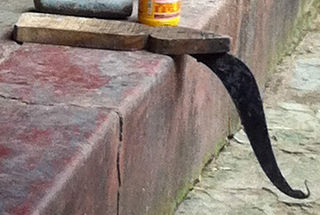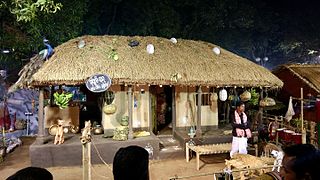
The sitar is a plucked stringed instrument, originating from the Indian subcontinent, used in Hindustani classical music. The instrument was invented in the 18th century, and arrived at its present form in 19th-century India. Khusrau Khan, an 18th-century figure of the Mughal Empire has been identified by modern scholarship as the inventor of the sitar. According to most historians, he developed the sitar from the setar, an Iranian instrument of Abbasid or Safavid origin.

Music of Malaysia is the generic term for music that has been created in various genres in Malaysia. A great variety of genres in Malaysian music reflects the specific cultural groups within multiethnic Malaysian society: Malay, Chinese, Indian, Dayak, Kadazan-Dusun, Bajau, Orang Asli, Melanau, Kristang and others.

Folk music of Haryana has two main forms: classical folk music of Haryana and desi folk music of Haryana. They take the form of ballads and pangs of parting of lovers, valor and bravery, harvest and happiness.

Dance in India comprises numerous styles of dances, generally classified as classical or folk. As with other aspects of Indian culture, different forms of dances originated in different parts of India, developed according to the local traditions and also imbibed elements from other parts of the country.

Sega is one of the major music genres of Mauritius and Réunion. It is a complete performance art, involving music, story-telling and traditional dance. Musically, the most modern forms common in Mauritius are its fusion genre Seggae and bhojpuri variations, whilst in Réunion we find the addition of maloya, the latter being much closer to the older, typical music influences originating from Madagascar. The variety of different sega forms is reflected in the multi-ethnic populous of the indigenous population of Mauritius.

Indian folk music is diverse because of India's enormous cultural diversity. It is sung in various languages and dialects throughout the length and breadth of this vast nation and exported to different parts of the world owing to migration.

The Juang are an Austroasiatic ethnic group found only in the Gonsaika hills of Keonjhar district of Odisha. Some Juangs, however migrated to neighbouring plains of Dhenkanal district of Odisha during the Bhuiyan revolt in the late 19th century. The Juang language belongs to the Munda family of the Austroasiatic languages. They are classified as a Scheduled Tribe by the Indian government. The 2011 census showed their population to be around 50,000.

The culture of West Bengal is an Indian culture which has its roots in Bengali literature, music, fine arts, drama and cinema. Different geographic regions of West Bengal have subtle as well as more pronounced variations between each other, with Darjeeling Himalayan hill region and Duars showing particularly different socio-cultural aspects.

The Santal people love music and dance. Like other ethnic groups of the Indian subcontinent, their culture has been influenced by mainstream Indian culture and by Western culture, but traditional music and dance still remain. Santal music differs from Hindustani classical music in significant ways. Onkar Prasad has done the most recent work on the music of the Santal but others preceded his work, notably W. G. Archer who collected and analyzed hundreds of Santal songs in the mid-twentieth century. The Santal traditionally accompany many of their dances with two drums: the Tamak' and the Tumdak'. The flute was considered the most important Santal traditional instrument and still evokes feelings of nostalgia for many Santal.

The Kalbelia are a snake charming tribe from the Thar Desert in Rajasthan, India. The dance is an integral part of their culture and performed by men and women.

Gamcha, also known as Gamchha, Gamucha, Gamusa and Angochha, is a rectangular piece of traditional coarse cotton cloth, sometimes with a checked design, worn as traditional scarf by men in the Indian subcontinent, mainly in Eastern India, Bangladesh, as well as in eastern Terai of Nepal. It also became bit popular in other cultures of India and now in what is known as Pakistan after the Indian partition, as well as various parts of South and Southeast Asia. The word "Gamcha" is Bengali/Assamese word which comes from two very simple and commonly used Bengali/Assamese words, (গা) ga which means "Body", and (মুছা) mucha which means "wipe". Literally translated, it means 'something to wipe the body with' however, interpreting the word gamcha as the towel is misleading. It is often worn on one side of the shoulder. Its appearance varies from region to region, and it has been traditionally worn as a scarf by the Odia men and Bengali men. Gamcha is also a headwear for Bengali men in Bangladesh. Gamucha was also mentioned in Odia Mahabharata by Sarala Dasa as part of the traditional dress of Odia men. Weavers of traditional tantubaya or jugi community migrated from Bangladesh to Tripura and weavers of Odisha produce good quality gamucha.
The Kela are a Hindu community found in the states of Gujarat and Rajasthan in India. They are also known as Dhat Maheshwari.

Parai also known as Thappattai or Thappu is a traditional percussion instrument from South India. It is a traditional instrument used to make announcements and played during festivals, folk dances, weddings and functions. The instrument in played predominantly by Tamil people in Tamil Nadu and other regions with significant Tamil diaspora such as Sri Lanka. There are many variants of the instrument, but generally consists of a drum made of wood, open on one side and closed with a stretched animal hide on the other side along with two wooden sticks used for beating the drum.
Sambalpur, in Western Odisha, is a region that has a distinct cultural identity. The songs, clothing, dances, language, Food and festivals celebrated in Sambalpur and Western Odisha are unique. This distinct cultural identity arises from the strong association of the tribal and folk communities which have been coexisting in Sambalpur and Other Districts Of Western Odisha Region for centuries.

Paniki is a traditional East Indian tool with a cutting edge with a wooden footrest. Panikis are used in the kitchen for chopping vegetables, fish and meat. Panikis are mostly found in Odisha, India and the variations of the tool is known as Boti in West Bengal and Tripura in India and in Bangladesh. Various tribes of Odisha used for different purposes. The tribe members of the Mutkia Kondha worship paniki as deity and do not keep their feet with their feet. They rather use a special type of paniki with a wooden stand. Panikis of ancient times show engraving of cultural and religious elements. Traditionally in rural Odisha, panikis are made from wrought iron or recycled steel by the blacksmith.

The Bathudi or Bathuri is a community found mainly in the north western part of Odisha. Some Bathudis, however migrated to neighbouring states of Jharkhand and West Bengal. The 2011 census showed their population to be around 220,859. They are classified as a Scheduled Tribe by the Indian government.
Gopal or Gouda is an Indian caste, from Odisha State in East India. Their traditional occupations include dairy farming, cattle herding, cultivation and carrying palanquins of deities. They also worked as Paikas (soldiers) under the kings. Gopal is the name of the milkmen or herdsmen caste in Odisha, which is known by other names in various parts of India.

Mardala is a classical percussive instrument native to the east Indian state of Odisha, traditionally used as the primary accompaniment in Odissi classical music. The instrument is slightly different from other instruments that might have similar names in the Indian subcontinent due to its unique construction, acoustic features and traditional playing technique.

The anandalahari is a chordophone Indian musical instrument. The instrument often accompanies dance, and may act as melody and rhythm.
Gajapati Rāmachandra Deva I was the founder of the Bhoi dynasty of Khurda in Odisha, India. He became the ruler of Khurda kingdom after defeating Mukunda Deva in 1568. He claimed descent from the Yaduvanshi dynasty which features prominenetly in the Indian epic, Mahabharata. The Odia populace gave him the title of "Thakura Raja" as a mark of respect for renovating the damaged Hindu temples that were destroyed by the invasion of Kalapahad. He was titled as Vira Sri Gajapati Viradhi Viravara Pratapi Ramachandra Deva.















